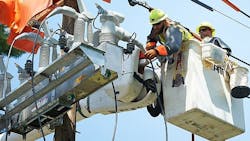Build the Grid of the Future, Not the Grid of the Past
As more critical aspects of our lives depend on access to power, the need to advance and modernize our electric grid becomes more urgent.
Recently, I’ve seen a number of articles that talk about “grid-modernization projects.” These so-called modern projects involve the deployment of technology invented in the 1940s, such as conventional circuit breakers or reclosers. While these were fine solutions back in the 1940s, before the energy transition and changing consumer expectations of service, don’t forget that at that time, the U.S. population was around 123 million and few homes had more than a few lights and a refrigerator.
Up until 10 to 20 years ago, most networks were still getting by using basic reclosing technology. However, at 332 million, the U.S. population has nearly tripled, and technological advancements mean more people, appliances, computers, and handheld devices are dependent on all things electric. Add to this the increased frequency and intensity of severe weather affecting the grid and causing widespread outages, and it’s clear the old conventional solutions simply don’t meet our needs.
What was previously adequate segmentation between power distribution sections to minimize outages and re-direct power during a storm can cause “blinks” of power that knock out modern-day electronics. With so much of our critical infrastructure and healthcare equipment dependent on electricity, this is not acceptable. Moreover, it is simply outdated technology.
Imagine if we were still using telephone technology from the 1940s to communicate with our smart appliances! We would not be very successful. Today, my smart refrigerator can talk to my smart phone to let me know when we’re out of juice at home.
Yet we are relying on the last century’s grid technology to power it. There’s nothing smart about this approach.
Consider how the grid and its technology have evolved over the past 100+ years:
- Utility 1.0 (1910s)–Dawn of the electrical age. Fuses were state-of-the-art.
- Utility 2.0 (1930s and 40s)–Electrification of the U.S. Conventional reclosers were introduced.
- Utility 3.0 (1990s)–The pre-Internet age. Automation was first used.
- Utility 4.0 (2020s and beyond)–Power is needed for all aspects of our daily lives. The reliability and resilience of the grid is more critical than ever.
Now let’s talk about last century’s recloser technology. Patented in the 1940s, conventional reclosers are used to test whether faults on a feeder are temporary and, if so, restore power to avoid outages. These reclosers perform their function by stepping through a pre-programmed sequence of operations that risks putting the full fault current back onto the power system every time they test into a short circuit multiple times in a row.
By repeatedly doing this, conventional reclosers put extreme pressure on the rest of the grid, cause equipment damage, and weaken the overall power system. This ultimately increases the frequency, duration, and number of power outages, resulting in major disruptions and unhappy customers.
As we look to advance our grid, prepare for the energy transition, and face the challenges of worsening weather, conventional reclosers will not provide the lasting improvements or transformational change we need.
To build a grid that handles the needs of today and anticipates the needs of tomorrow, we need innovative distribution grid technology. The great news is that advanced fault interrupters use 95% less energy to test for faults, sending less current through the line. This low-impact testing creates far less stress on the aging grid, meaning it can be used effectively in a wider variety of applications.
More devices can be installed on a line to increase segmentation without risking miscoordination, which ultimately reduces the impact of outages and improves reliability. Low-stress fault-testing also reduces voltage sags, making it possible to test for faults, even on underground cables, as utilities bury more lines. This avoids damage and minimizes outages.
Working with other intelligent devices, advanced fault interrupters are part of a systemwide approach that will help to build a self-healing, resilient, and truly modern grid that meets all of our needs. To build the grid that powers our future, we need to invest right now in today’s innovative technologies, not those of yesterday.
By looking ahead when upgrading and modernizing the grid toward Utility 4.0 and beyond, we can substantially improve the reliability and resilience of our power infrastructure. We have the technology today that can help us build toward an outage-free future.
